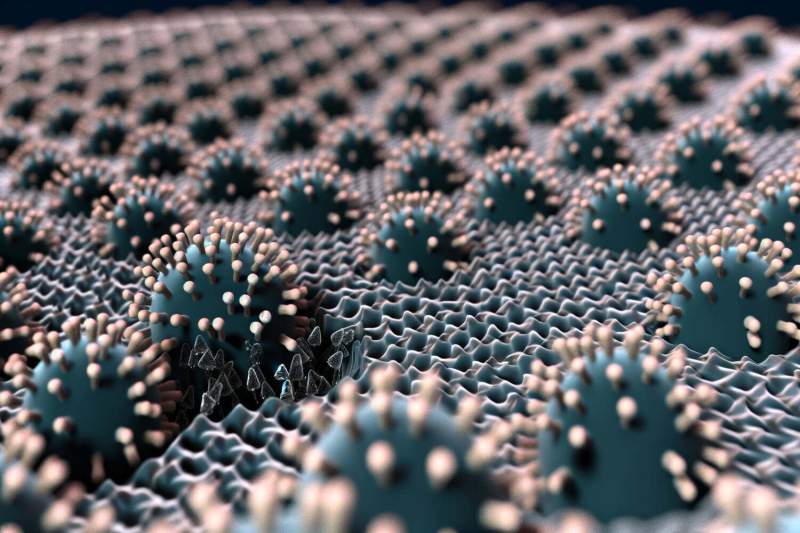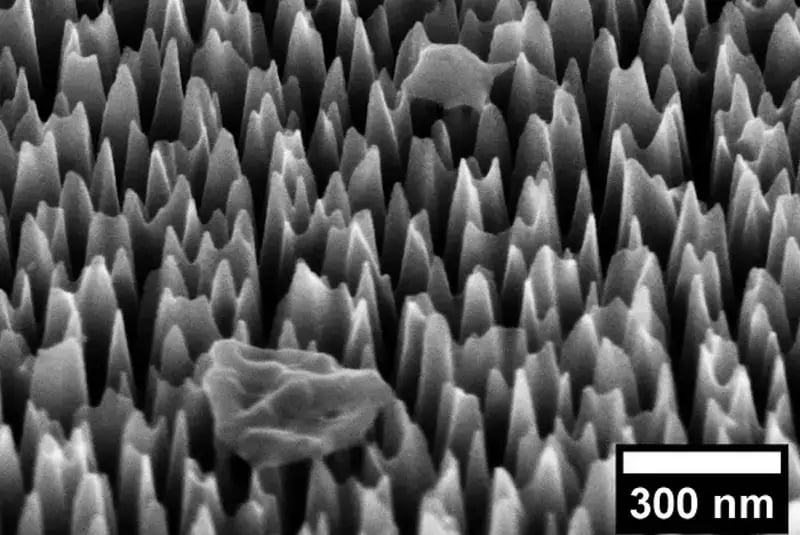
© Image generated by DALL-E AI for Presse-Citron
A team from the Royal Melbourne Institute of Technology (RMIT) in Australia worked for two years to create a revolutionary material. This is intended to secure laboratories, hospitals and other sensitive environments where asepsis is essential. At first glance, this nanomaterial appears like a completely flat black mirror; on a microscopic scale, it appears to be a lethal surface for pathogens.
The results of their work were published in a study published in the journal ACS Nano of the American Chemical Society in December 2023.
A design inspired by nature
To design this new kind of material, the researchers were inspired by the structural composition of the wings of certain insects, including cicadas and dragonflies. Their surfaces, when looked at more closely, present natural nanostructures. Nanostructures are “ nanometric-sized objects (holes, pads, tracks, etc.) often arranged in the form of periodic networks ” according to the definition of Techniques de the engineer.
They protect these insects by acting like real blades at the microscopic level, capable of piercing and destroying pathogenic agents: spores fungal, bacterial cells, etc.
Inspired by this structure, the researchers developed a silicon surface, covered nanospikes, very thin and razor-sharp spikes that can target and completely neutralize viruses. This surface proves to be very effective, particularly against hPIV-3 virus cells, a pathogen responsible for respiratory diseases such as pneumonia, croup and bronchitis. It manages to destroy 96% of these cells, by perforating their viral envelope and thus blocking their reproduction.
If their material is produced on a large scale, it could reduce the dependence of sterilization methods on chemical disinfectants.
A fairly complex production
We can imagine, designing this surface covered with nanospikes n& ;#8217;is not accessible to everyone and its manufacturing process is rather complicated. In order to achieve this result, the researchers subjected a silicon wafer to ion bombardment. A process which took place at the Melbourne Center for Nanofabrication and which allowed this wafer to acquire this very particular structure.
The bombardment allowed to create countless spikes, nanospikes, approximately thick2 nanometers and 290 nanometers high. They are approximately 30,000 times finer than a human hair. As we can see in the capture below, we can clearly see the viruses skewered on the tips.

© RMIT
Samson Mah, doctoral student and first author of the study, explained: “ Embed This advanced technology in high-risk environments such as laboratories or healthcare settings, where exposure to hazardous biological materials is a concern, could significantly strengthen containment measures against infectious diseases< /em> ”. According to him, this would create “safer environments for researchers, health professionals and patients”.< /p>
Towards a reduction in the use of chemical disinfectants ?
As written above, the whole point of such a material lies in its ability to eliminate pathogens by mechanical action and not chemical. Due to the intensive use of chemical disinfectants in certain environments, particularly medical ones, there are more and more bacteria and viruses entirely resistant to these products.
These agents, nicknamed superbugs, are the subject of growing concern as the threat they represent on a global scale is significant. Because of them, certain infections become increasingly difficult to treat and existing antibiotics and antivirals are sometimes insufficient. Nanospikes could play a fundamental role in reducing this threat.
We could imagine this material applied in various medical devices: textiles, walls, floors or air filtration systems. It is not yet known, but these nanospikes could also be effective against a wider range of pathogens, including bacteria and fungi.
RMIT scientists' approach, combining biomimetics with cutting-edge manufacturing technologies, has paid off. It could very well mark a turning point in the field of infection prevention, especially when we know that we will certainly experience in the future much more virulent pandemics than ;#8217;was that of COVID-19.
- A team from RMIT in Australia have developed a revolutionary material.
- Inspired by insects, this material is covered with nanospikes allowing viruses to be mechanically eliminated with very high efficiency.
- Its use could reduce our dependence on chemical disinfectants.
📍 To not miss any news from Presse-citron, follow us on Google News and WhatsApp.
325.5 k reviews
[ ]

